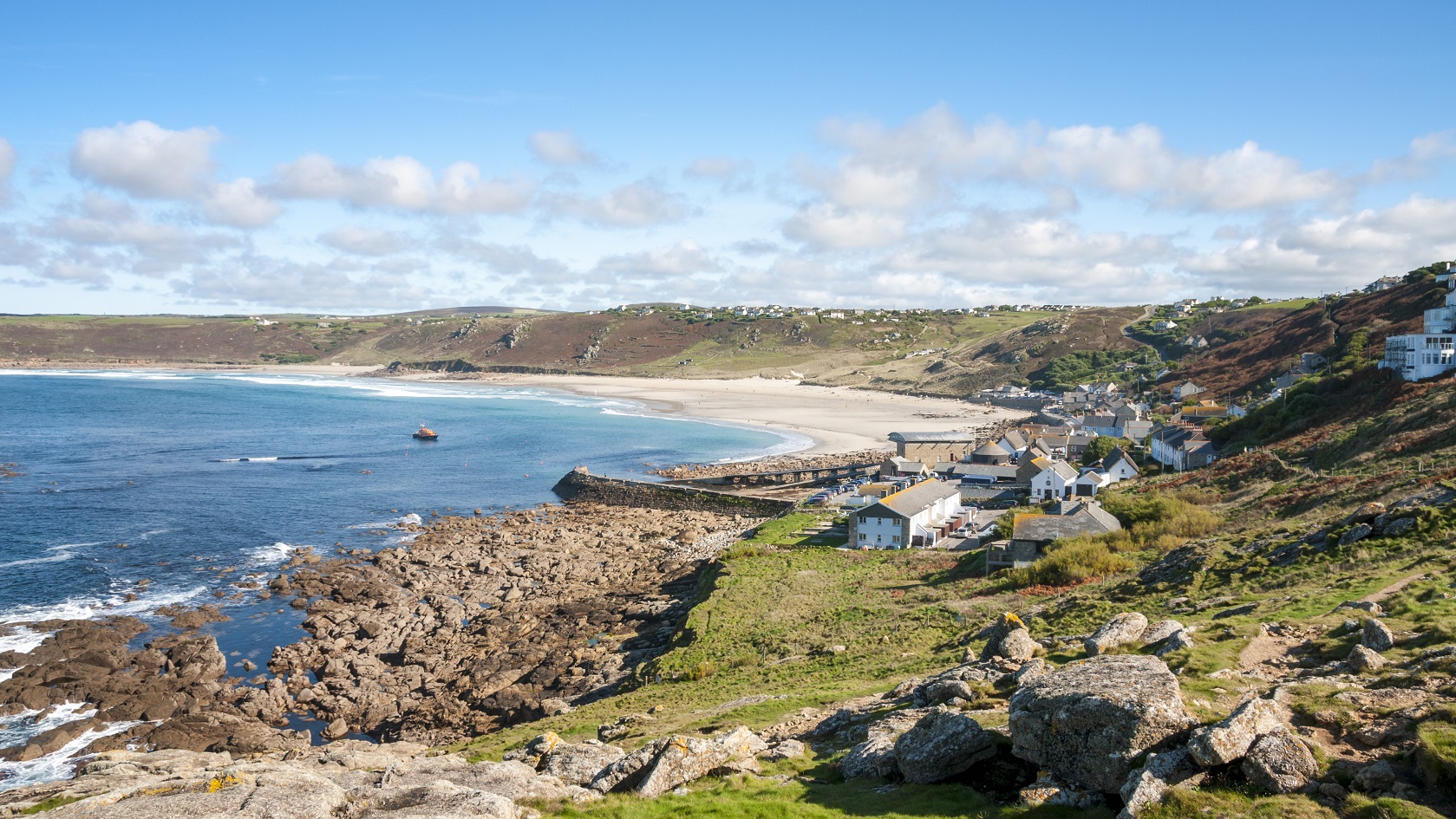Top 5 Challenging South Coast Path Walks
The UK's longest National Trail, the South West Coast Path, offers some of the most stunning scenery in the country and plenty of opportunities to get outdoors, whether you're a weekend walker or seasoned long-distance hiker. If you're looking for something a bit more demanding than a country stroll, we've rounded up our top 5 challenging walks in this iconic area, rewarded with some incredible views.
Langdon Hill, Golden Cap & St Gabriel's Chapel Walk, Dorset
Distance: 4.3 miles

©Andreas Byrne
This dramatic 4.7-mile walk is a true highlight for adventurous hikers, taking you to the summit of Great Hangman - the highest sea cliff in England and the loftiest point on the entire South West Coast Path. The route is both physically demanding and visually rewarding, offering a unique blend of coastal grandeur, deep valleys, and fascinating history.
Why It’s a Top Challenging South Coast Path Walk:
- The ascent to Golden Cap is steep and sustained, demanding both stamina and determination.
- Multiple steep descents and climbs along the route ensure your legs (and lungs) get a thorough workout.
- The reward: panoramic coastal views stretching from Lyme Regis to Portland, and a sense of achievement at conquering the highest point on the south coast.
Walk Overview
Route Highlights:
- Start and finish at Langdon Hill National Trust car park, easily accessed from the A35.
- The trail combines woodland paths, open fields, and rugged coastal tracks, offering a constantly changing landscape.
- Key features include:
- The summit of Golden Cap (191m)
- The atmospheric ruins of St Gabriel’s Chapel
- The “lost” medieval hamlet of Stanton St Gabriel, with its centuries-old history
Walk Stages and Features:
- Begin with a gentle woodland loop through Langdon Hill, surrounded by Scots pine and larch, and enjoy glimpses of the Dorset countryside.
- After about half a mile, branch off for the main challenge: the climb up Golden Cap. This section is steep, with steps and rough ground, but the summit rewards you with sweeping views across Lyme Bay and the rolling West Dorset hills.
- Pause at the top to catch your breath and soak in the views—this is the highest point on the south coast, and on a clear day you can see for miles in every direction.
- Descend carefully down the steep steps towards the valley and follow the signposted path to St Gabriel’s Chapel. The descent can be tough on the knees, especially in wet weather.
- Explore the haunting remains of the 13th-century chapel, once part of the now-abandoned hamlet of Stanton St Gabriel. Local legends and tales of smugglers add to the intrigue of this spot.
- Return via tranquil woodland paths through St Gabriel’s Wood, especially beautiful in spring when bluebells and wild garlic are in bloom.
- The final stretch brings you back to the car park, completing a loop that’s as rewarding as it is challenging.
Key Practical Details:
- Terrain: Expect gravel paths, dirt tracks, grass, and numerous steps. Some sections are muddy and slippery after rain.
- Elevation Gain: Around 299m, with the most significant climb up Golden Cap itself.
- Facilities: None on the route itself. Nearest toilets, pub, and café are at Seatown.
- Accessibility: Not suitable for pushchairs or those with limited mobility. Several kissing gates and livestock in fields - dogs should be kept under close control.
- Parking: Paid parking at Langdon Hill car park.
Walk Highlights at a Glance:
- Steep climbs and descents for a real physical challenge
- Summit of Golden Cap: highest sea cliff in southern England
- Ruined St Gabriel’s Chapel and the story-rich hamlet of Stanton St Gabriel
- Ever-changing scenery: ancient woodland, open fields, and dramatic coastline
- Exceptional views across the Jurassic Coast and inland Dorset hills
The Langdon Hill, Golden Cap & St Gabriel’s Chapel walk is a must for anyone seeking a challenging and memorable South Coast adventure. With its demanding climbs, rich history, and some of the finest views in Dorset, this route exemplifies why the South West Coast Path is famed among walkers.
Route and information for the Langdon Hill, Golden Cap & St Gabriel’s Chapel walk.
The Hangmen Hills, Exmoor
Distance: 4.7 miles

©Andrew Wheatle
This dramatic 4.7-mile walk is a true highlight for adventurous hikers, taking you to the summit of Great Hangman - the highest sea cliff in England and the loftiest point on the entire South West Coast Path. The route is both physically demanding and visually rewarding, offering a unique blend of coastal grandeur, deep valleys, and fascinating history.
Why It’s One of the Top Challenging South Coast Path Walks:
- The route climbs to 318 metres (1,043 feet) at Great Hangman, making it the highest point on the Exmoor coast and the South West Coast Path.
- Expect a long, steady ascent from sea level, with a climb of around 200 metres (650 feet) that, while not exceptionally steep, is relentless and requires a good level of fitness.
- The walk traverses rugged cliffs and combes, with deep valleys and dramatic drops to the sea below, ensuring a challenging and exhilarating experience.
Walk Overview
Route Highlights:
- Start in Combe Martin: The walk begins in the picturesque village of Combe Martin, nestled at the western edge of Exmoor National Park.
- Little Hangman: Early in the walk, you’ll ascend Little Hangman (218m/716ft), which overlooks the village and offers impressive views of the surrounding coastline.
- Great Hangman: The main challenge is the steady climb to Great Hangman, the highest sea cliff in England, with a sheer cliff face dropping 244 metres (800 feet) to the sea.
- Spectacular Views: From the cairn at the summit, take in far-reaching vistas over the Bristol Channel, the wild Exmoor hills, and along the North Devon coast.
- Geological Interest: The cliffs are formed from ancient Devonian sandstone, known as the Hangman Grits, and the area is rich in geological history.
- Historic Features: Pass the site of an old iron ore working at Blackstone Point and explore the landscape that inspired local legends and literary works.
Walk Features and Terrain:
- Long, steady climbs and descents - expect to be challenged both on the way up and down.
- Paths can be rugged and exposed, with sections that may be muddy or slippery after rain.
- The route is mostly open, with little shelter from wind or sun, especially on the higher ground.
- The walk is within an Area of Outstanding Natural Beauty, with abundant wildlife and wildflowers in spring and summer.
Key Practical Details:
- Elevation Gain: Approximately 318 metres (1,043 feet) to the summit of Great Hangman.
- Facilities: Limited on the route itself; amenities are available in Combe Martin at the start and end of the walk.
- Parking: Use the Kiln Car Park in Combe Martin as your base.
- Suitability: Best for experienced walkers with good fitness; not suitable for pushchairs or those with limited mobility.
- Dog Friendly: Dogs are welcome but should be kept under close control due to livestock and steep drops.
Walk Highlights at a Glance:
- Highest sea cliff in England and the South West Coast Path
- Challenging, steady climbs and exhilarating descents
- Stunning panoramic views over Exmoor and the Bristol Channel
- Fascinating geology and local legends
- Rich in wildlife and wildflowers, especially in spring
The Hangmen Hills walk is a classic Exmoor challenge, combining physical exertion with some of the most awe-inspiring views in the South West. From the relentless climb to Great Hangman’s summit to the wild, windswept beauty of the cliffs and valleys, this route is a must for anyone seeking a memorable and demanding coastal adventure.
Sennen To Coverack, Cornwall
Distance: 56 miles

©Dean Feast
Embark on a truly epic five-day adventure along the wild, windswept cliffs of Cornwall’s far west and south. The Sennen to Coverack route is a standout challenge on the South West Coast Path, weaving through some of the most dramatic and storied landscapes in England. This walk is not just a test of stamina, but a journey through geological wonders, mining heritage, and the raw beauty of the Atlantic coast.
Why It’s a Top Challenging South Coast Path Walk:
- At 56 miles, this is an extended trek demanding endurance, with daily distances averaging around 11–12 miles.
- The route is packed with steep ascents and descents, rugged terrain, and exposed headlands that test even experienced walkers.
- You’ll pass two of England’s most iconic landmarks: Land’s End, the most westerly point, and Lizard Point, the most southerly.
Walk Overview
Route Highlights:
- Land’s End: Marvel at the granite cliffs and crashing waves at England’s westernmost tip. The area is famed for its dramatic rock formations and panoramic sea views.
- Mining Heritage: Walk past the haunting ruins of old tin and copper mines, especially around Cape Cornwall and the St Just area, where engine houses perch on cliff edges.
- Lizard Point: Reach the most southerly point in mainland Britain, with its distinctive serpentine rocks and rare wildflowers.
- Secluded Coves & Beaches: Discover hidden gems like Porthcurno, Kynance Cove, and Mullion Cove, each with turquoise waters and sandy beaches.
- Wildlife & Flora: Look out for seabirds, seals, and in spring and summer, a riot of coastal wildflowers.
Terrain & Challenge:
- Expect a mix of narrow cliff-top paths, rocky sections, sandy beaches, and occasional woodland.
- Frequent elevation changes make this a physically demanding walk, with some sections requiring careful footing, especially after rain.
- The route is well-waymarked but can feel remote between villages - be prepared for long stretches without facilities.
Key Practical Details:
- Accommodation: Options include B&Bs, hostels, and campsites in villages along the route. Booking ahead is recommended, especially in summer.
- Transport: Good bus links connect main points, but some villages are remote - plan your logistics in advance.
- Facilities: Cafés, pubs, and shops are scattered along the route, but carry water and snacks for longer, isolated stretches.
- Best Time to Walk: Late spring to early autumn for the best weather and longest daylight hours.
Walk Highlights at a Glance:
- Traverse Cornwall’s wildest cliffs and most famous headlands
- Land’s End and Lizard Point: England’s extreme west and south
- Ancient mining ruins and World Heritage landscapes
- Secluded beaches, turquoise coves, and abundant wildlife
- Five days of unforgettable coastal adventure
The Sennen to Coverack walk is a classic, demanding journey along the South West Coast Path, offering a perfect blend of physical challenge and spectacular scenery. From towering granite cliffs and storm-lashed headlands to tranquil coves and ancient ruins, every mile is packed with drama and natural beauty - making it a must for any serious coastal walker.
Heddon's Mouth, Somerset
Distance: 2.1 miles

© Audrey Rowlatt
Heddon's Mouth offers a unique South Coast Path challenge - especially for those with limited mobility - thanks to the availability of Tramper all-terrain mobility scooters for hire from the National Trust at Heddon Valley. This short but rewarding walk takes you through ancient woodland and along a tranquil river valley, culminating at a secluded shingle beach framed by dramatic cliffs.
Why It’s a Top Challenging South Coast Path Walk:
- The route is accessible for many with limited mobility when using a Tramper, making it a rare opportunity to experience the wild beauty of Exmoor’s coastline up close.
- The walk is short in distance but can be physically demanding for manual wheelchair users due to uneven terrain and gradients.
- The sense of adventure is heightened by the dramatic landscape - steep, scree-clad hillsides, ancient woodland, and the sound of the River Heddon as it winds to the sea.
Walk Overview
Route Highlights:
- Start at Heddon Valley National Trust Car Park: Begin your journey near The Hunter’s Inn, a welcoming country pub and a great spot for refreshments before or after your walk.
- Ancient Woodland: The path meanders through lush, leafy woodland, especially vibrant in spring with carpets of bluebells, wild violets, and red campions.
- Riverside Path: Follow the gentle course of the River Heddon, listening to the soothing sounds of water and birdsong as you make your way toward the coast.
- Secluded Shingle Beach: Reach Heddon’s Mouth, a tiny, pebbled cove surrounded by steep hills and dramatic cliffs—a perfect place to pause, picnic, and take in the wild scenery.
- Wildlife and History: Look out for rare butterflies, deer, and seabirds. The area is rich in stories of smugglers and even wartime U-boat activity.
Accessibility and Challenge:
- Tramper Mobility Scooters: These all-terrain vehicles can be hired from the National Trust, making the route accessible for many who would otherwise find the terrain too challenging.
- Path Conditions: While the main route to Heddon’s Mouth is relatively gentle, some sections can be muddy or uneven. The Tramper makes these manageable for most users, but manual wheelchair users may find the gradients and surfaces demanding.
- Rest Points: Benches are available along the route, providing opportunities to rest and enjoy the tranquil surroundings.
Practical Information:
- Parking: National Trust car park at Heddon Valley; free for members or pay and display for non-members.
- Facilities: Toilets and refreshments available at The Hunter’s Inn near the start and finish of the walk.
- Dog Friendly: Dogs are welcome but should be kept under close control, especially where livestock may be present.
- Best Time to Visit: Spring and summer for wildflowers and butterflies, but the walk is beautiful year-round.
Walk Highlights at a Glance:
- Accessible adventure for those with limited mobility using a Tramper
- Ancient woodland, riverside paths, and a secluded shingle beach
- Dramatic cliffs and geological features of Exmoor’s coast
- Rich in wildlife, wildflowers, and local history
- Short but memorable route, perfect for a half-day outing
Heddon’s Mouth is a standout on the South Coast Path, offering both a physical and logistical challenge for those with limited mobility. With its combination of accessible adventure, spectacular scenery, and a touch of Exmoor’s wild spirit, it’s a must for anyone seeking a memorable and inclusive coastal experience.
The 630-Mile Experience

The South West Coast Path is perhaps the UK’s ultimate challenge for the long-distance hiker. A fast walker can complete the 630 miles from Minehead in Somerset to Poole in Dorset in around 30 days, but a more leisurely pace is between seven and eight weeks. No matter how long it takes, it is a stunning achievement. The height gained and lost is the equivalent of climbing Mount Everest 4 times!
Routes and information on the 630-mile South West Coast Path.
South West Coast Path FAQs
The South West Coast Path is England’s longest waymarked National Trail, stretching 630 miles from Minehead in Somerset to Poole Harbour in Dorset. It follows the dramatic coastline through Exmoor, North Devon, Cornwall, South Devon, and Dorset, offering breathtaking scenery and a variety of landscapes along the way.
The Path is considered one of the UK’s ultimate long-distance walking challenges, with over 115,000 feet of ascent and descent - equivalent to climbing Mount Everest four times. While some sections are easier, many parts are strenuous, featuring steep climbs and rugged terrain, so planning according to your fitness level is essential.
No, most walkers complete the South West Coast Path in sections, often over several holidays or years. The official guidebook and website break the route into 52 sections, each typically a day’s walk, making it easy to plan shorter trips or tackle the entire trail at your own pace.
Highlights include picturesque fishing villages, golden beaches, dramatic cliffs, and abundant wildlife such as dolphins and seabirds. The most favourable weather is between March and September, but the path offers unique beauty year-round, from stormy seas to tranquil summer days.
Yes, the trail is fully waymarked as a National Trail, using acorn symbols and commemorative markers at key points like Minehead (start), Porthallow (mid-point), and South Haven Point (end). Waymarkers also indicate distances along the route, making navigation straightforward in both directions.
The Path is renowned for its diverse wildlife, including seabirds, seals, dolphins, and wildflowers. Walkers enjoy ever-changing coastal scenery - rocky headlands, secluded coves, woodlands, and sweeping sea views - making every section unique and rewarding.
Good walking boots, weather-appropriate clothing, and a reliable guidebook or map are recommended. Due to the challenging terrain, be prepared for steep ascents and descents, and plan your daily distances realistically, especially if you’re new to long-distance walking.
Related articles

Let us know you agree to cookies
We use marketing, analytical and functional cookies as well as similar technologies to give you the best experience. Third parties, including social media platforms, often place tracking cookies on our site to show you personalised adverts outside of our website.
We store your cookie preferences for two years and you can edit your preferences via ‘manage cookies’ or through the cookie policy at the bottom of every page. For more information, please see our cookie policy.




